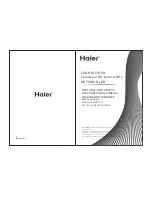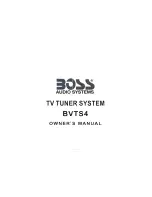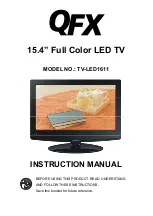
Safety Instructions, Warnings, and Notes
EN 5
EBJ1.0U
2.
semiconductors in the unit, irrespective of the type
indication on these semiconductors.
•
Manufactured under license from Dolby Laboratories.
“Dolby”, “Pro Logic” and the “double-D symbol”, are
trademarks of Dolby Laboratories.
2.4.2
Schematic Notes
•
All resistor values are in ohms, and the value multiplier is
often used to indicate the decimal point location (e.g. 2K2
indicates 2.2 kohm).
•
Resistor values with no multiplier may be indicated with
either an "E" or an "R" (e.g. 220E or 220R indicates 220
ohm).
•
All capacitor values are given in micro-farads (
µ=
x10
-6
),
nano-farads (n= x10
-9
), or pico-farads (p= x10
-12
).
•
Capacitor values may also use the value multiplier as the
decimal point indication (e.g. 2p2 indicates 2.2 pF).
•
An "asterisk" (*) indicates component usage varies. Refer
to the diversity tables for the correct values.
•
The correct component values are listed in the Spare Parts
List. Therefore, always check this list when there is any
doubt.
2.4.3
Rework on BGA (Ball Grid Array) ICs
General
Although (LF)BGA assembly yields are very high, there may
still be a requirement for component rework. By rework, we
mean the process of removing the component from the CBA
and replacing it with a new component. If an (LF)BGA is
removed from a CBA, the solder balls of the component are
deformed drastically so the removed (LF)BGA has to be
discarded.
Device Removal
As is the case with any component that is being removed, it is
essential when removing an (LF)BGA, that the board, tracks,
solder lands, or surrounding components are not damaged. To
remove an (LF)BGA, the board must be uniformly heated to a
temperature close to the reflow soldering temperature. A
uniform temperature reduces the risk of warping the CBA.
To do this, we recommend that the board is heated until it is
certain that all the joints are molten. Then carefully pull the
component off the board with a vacuum nozzle. For the
appropriate temperature profiles, see the IC data sheet.
Area Preparation
When the component has been removed, the vacant IC area
must be cleaned before replacing the (LF)BGA.
Removing an IC often leaves varying amounts of solder on the
mounting lands. This excessive solder can be removed with
either a solder sucker or solder wick. The remaining flux can be
removed with a brush and cleaning agent.
After the board is properly cleaned and inspected, apply flux on
the solder lands and on the connection balls of the (LF)BGA.
Note:
Do not apply solder paste, as this has been shown to
result in problems during re-soldering.
Device Replacement
The last step in the repair process is to solder the new
component on the board. Ideally, the (LF)BGA should be
aligned under a microscope or magnifying glass. If this is not
possible, try to align the (LF)BGA with any board markers.
So as not to damage neighbouring components, it may be
necessary to reduce some temperatures and times.
More Information
For more information on how to handle BGA devices, visit this
URL:
www.atyourservice.ce.philips.com
not available for all regions). After login, select “Magazine”,
then go to “Repair downloads”. Here you will find Information
on how to deal with BGA-ICs.
2.4.4
Lead-free Solder
Philips CE is producing lead-free sets (PBF) from 1.1.2005
onwards.
Identification:
The bottom line of a type plate gives a 14-digit
serial number. Digits 5 and 6 refer to the production year, digits
7 and 8 refer to production week (in example below it is 1991
week 18).
Figure 2-2 Serial number example
Regardless of the special lead-free logo (which is not always
indicated), one must treat all sets from this date onwards
according to the rules as described below.
Figure 2-3 Lead-free logo
Due to lead-free technology some rules have to be respected
by the workshop during a repair:
•
Use only lead-free soldering tin Philips SAC305 with order
code 0622 149 00106. If lead-free solder paste is required,
please contact the manufacturer of your soldering
equipment. In general, use of solder paste within
workshops should be avoided because paste is not easy to
store and to handle.
•
Use only adequate solder tools applicable for lead-free
soldering tin. The solder tool must be able:
–
To reach a solder-tip temperature of at least 400°C.
–
To stabilise the adjusted temperature at the solder-tip.
–
To exchange solder-tips for different applications.
•
Adjust your solder tool so that a temperature of around
360°C - 380°C is reached and stabilised at the solder joint.
Heating time of the solder-joint should not exceed ~ 4 sec.
Avoid temperatures above 400°C, otherwise wear-out of
tips will increase drastically and flux-fluid will be destroyed.
To avoid wear-out of tips, switch “off” unused equipment or
reduce heat.
•
Mix of lead-free soldering tin/parts with leaded soldering
tin/parts is possible but PHILIPS recommends strongly
to
avoid
mixed regimes. If this cannot be avoided, carefully
clean the solder-joint from old tin and re-solder with new
tin.
•
Use only original spare-parts listed in the Service-Manuals.
Not listed standard material (commodities) has to be
purchased at external companies.
•
Special information for lead-free BGA ICs: these ICs will be
delivered in so-called "dry-packaging" to protect the IC
against moisture. This packaging may only be opened
shortly before it is used (soldered). Otherwise the body of
the IC gets "wet" inside and during the heating time the
structure of the IC will be destroyed due to high (steam-)
pressure inside the body. If the packaging was opened
before usage, the IC has to be heated up for some hours
(around 90°C) for drying (think of ESD-protection!).
Do not re-use BGAs at all
!
E_06532_024.eps
130606
MODEL :
PROD.NO:
~
S
32PF9968/10
MADE IN BELGIUM
220-240V 50/60Hz
128W
AG 1A0617 000001
VHF+S+H+UHF
BJ3.0E LA
P
b
Содержание EBJ1.0U
Страница 66: ...66 EBJ1 0U 7 Circuit Diagrams and PWB Layouts Layout SSB Top Side Part 1 G_16290_129a eps 130206 Part 1 ...
Страница 67: ...Circuit Diagrams and PWB Layouts 67 EBJ1 0U 7 Layout SSB Top Side Part 2 G_16290_129b eps 130206 Part 2 ...
Страница 69: ...Circuit Diagrams and PWB Layouts 69 EBJ1 0U 7 Layout SSB Bottom Side Part 1 Part 1 G_16290_130a eps 130206 ...
Страница 70: ...70 EBJ1 0U 7 Circuit Diagrams and PWB Layouts Layout SSB Bottom Side Part 2 Part 2 G_16290_130b eps 130206 ...
Страница 102: ...102 EBJ1 0U 7 Circuit Diagrams and PWB Layouts Layout SSB Top Side Part 1 Part 1 G_15861_030a eps 210606 ...
Страница 103: ...Circuit Diagrams and PWB Layouts 103 EBJ1 0U 7 Layout SSB Top Side Part 2 Part 2 G_15861_030b eps 210606 ...
Страница 105: ...Circuit Diagrams and PWB Layouts 105 EBJ1 0U 7 Layout SSB Bottom Side Part 1 Part 1 G_15861_031b eps 210606 ...
Страница 106: ...106 EBJ1 0U 7 Circuit Diagrams and PWB Layouts Layout SSB Bottom Side Part 2 Part 2 G_15861_031b eps 210606 ...
Страница 166: ...Revision List EN 166 EBJ1 0U 11 ...






































